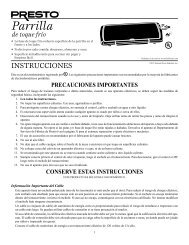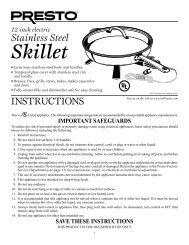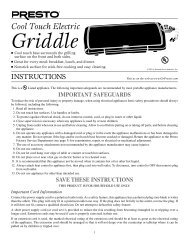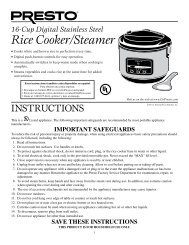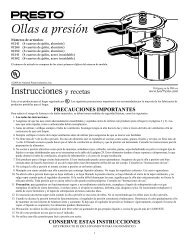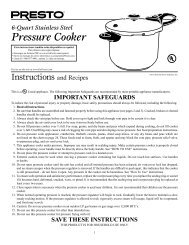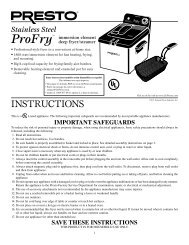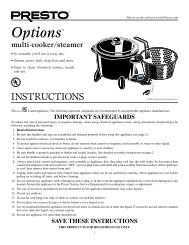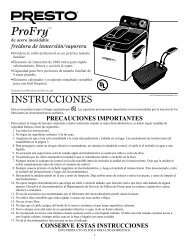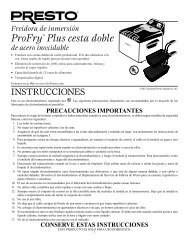Create successful ePaper yourself
Turn your PDF publications into a flip-book with our unique Google optimized e-Paper software.
Important Safety<br />
Information<br />
Cooking under pressure enables you to prepare food both quickly<br />
and deliciously. If used properly, your pressure cooker is one of<br />
the safest appliances in your kitchen. To ensure safe operation,<br />
make sure you always observe the following simple rules whenever<br />
you use the pressure cooker:<br />
1. Never overfill the pressure cooker. — The pressure regulator<br />
is designed to maintain cooking pressure at a safe level.<br />
It relieves excess pressure through the vent pipe as it rocks<br />
back and forth. Many foods tend to expand when cooked. If<br />
the cooker is overfilled, expansion of food may cause the vent<br />
pipe to become blocked or clogged. If the vent pipe becomes<br />
blocked, it cannot relieve excess pressure.<br />
Do not fill the cooker above the 2 ⁄3 fill line when cooking most<br />
foods. When cooking foods that foam, froth, or expand, such<br />
as rice, grains, dry beans and peas, or foods that are mostly<br />
liquid, such as soups, never fill the cooker above the 1 ⁄2 fill<br />
line.<br />
For your convenience, both the 2 ⁄3 and 1 ⁄2 full levels are marked<br />
by indentations on the side<br />
of the pressure cooker body 2<br />
⁄3 fill line<br />
(see Fig. M). The upper<br />
1<br />
⁄2 fill line<br />
marking indicates the 2 ⁄3<br />
full level and the lower the<br />
1<br />
⁄2 full level. In addition, in<br />
each section of the recipes<br />
you will find instructions on Fig. M<br />
the maximum fill level for<br />
each type of food.<br />
Reminder: When cooking any food, do not let any portion<br />
extend above the maximum fill mark. When cooking rice,<br />
grains, dry beans and peas, soups, and stews, the cooker<br />
should never be more than 1 ⁄2 full.<br />
2. Always add cooking liquid. — If an empty pressure cooker<br />
is heated or if a cooker boils dry, the cooker will overheat<br />
excessively causing possible discoloration and/or damage to<br />
the cooker.<br />
3. Always look through the vent pipe before using the cooker<br />
to make sure it is clear. — If the vent pipe is blocked, it<br />
cannot function as it should and thus cannot relieve excess<br />
pressure. Pressure may then build to unsafe levels. To clean<br />
the vent pipe, see page 15.<br />
4. Always fully close the pressure cooker. — The cooker is<br />
fully closed when the cover handle is directly above the body<br />
handle. Your pressure cooker has specially designed lugs on<br />
the cover and body which lock the cover in place when the<br />
cooker is fully closed. However, if the cooker is not fully<br />
closed, the lugs cannot lock the cover onto the body. It’s possible<br />
that pressure could build inside the cooker and cause<br />
the cover to come off and result in bodily injury or property<br />
damage. Always be sure the cover handle is directly above<br />
the body handle (see page 9, Fig. H). Do not turn past handle<br />
alignment.<br />
5. Never open the cooker when it contains pressure. — The<br />
air vent /cover lock provides a visual indication of pressure<br />
inside the cooker. When it is up, there is pressure. When it is<br />
down, there is no pressure in the cooker and it can be opened.<br />
If the pressure cooker is opened before all of the pressure is<br />
released, the contents of the cooker will erupt and could cause<br />
bodily injury or property damage.<br />
6. Check the overpressure plug. If it is hard, deformed,<br />
cracked, worn, or pitted, replace it immediately. — The<br />
12 13




